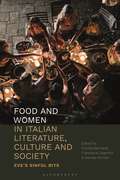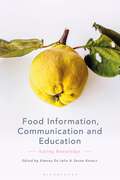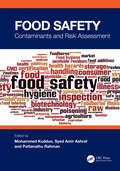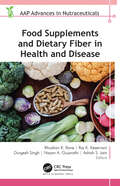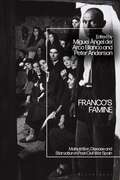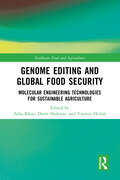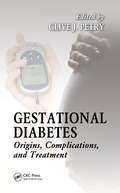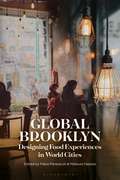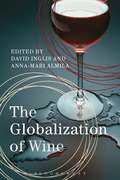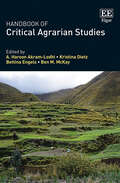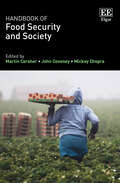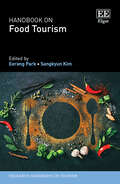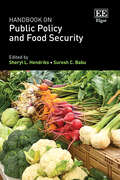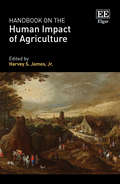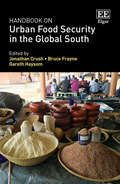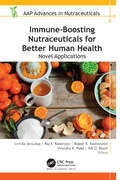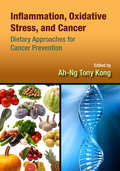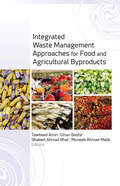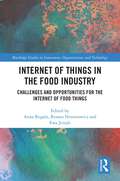- Table View
- List View
Food and Women in Italian Literature, Culture and Society: Eve's Sinful Bite
This book explores how women's relationship with food has been represented in Italian literature, cinema, scientific writings and other forms of cultural expression from the 19th century to the present.Italian women have often been portrayed cooking and serving meals to others, while denying themselves the pleasure of the table. The collection presents a comprehensive understanding of the symbolic meanings associated with food and of the way these intersect with Italian women's socio-cultural history and the feminist movement.From case studies on Sophia Loren and Elena Ferrante, to analyses of cookbooks by Italian chefs, each chapter examines the unique contribution Italian culture has made to perceiving and portraying women in a specific relation to food, addressing issues of gender, identity and politics of the body.
Food Information, Communication and Education: Eating Knowledge
Food Information, Communication and Education analyses the role of different media in producing and transforming knowledge about food. 'Eating knowledge', or knowledge about food and food practice, is a central theme of cooking classes, the daily press, school textbooks, social media, popular magazines and other media. In addition, a wide variety of actors have taken on the responsibility of informing and educating the public about food, including food producers, advertising agencies, celebrity chefs, teachers, food bloggers and government institutions. Featuring a range of European case studies, this interdisciplinary collection advances our understanding of the processes of mediatization, circulation and reception of knowledge relating to food within specific social environments. Topics covered include: popularized knowledge about food carried over from past to present; the construction of trustworthy knowledge in today's food risk society; critical assessment of nutrition education initiatives for children; and political and ideological implications of food information policy and practice.
Food Safety: Contaminants and Risk Assessment
Food Safety: Contaminants and Risk Assessment is a state-of-art reference on food safety, which is the biggest challenge in the food supply chains worldwide. Despite advancements in hygiene, food treatment, and food processing, foodborne pathogens or food contaminants still represent a significant threat to human health. This book presents comprehensive information about the major food contaminants across food types. The text provides facts about setting up food safety initiatives and safety rules, foodborne pathogen detection, production and processing compliance issues, and safety education.Key Features Examines a diverse range of contaminants across food types Describes various food allergens and allergies Discusses contamination in drinking water and bottled water Reviews the international regulations for management of food hazards Throws light on the overall impact of food safety of global food supply chains This book is meant for postgraduate students, researchers, and food industry professionals.
Food Supplements and Dietary Fiber in Health and Disease (AAP Advances in Nutraceuticals)
Here is an in-depth and informative introduction to dietary fibers and food supplements, elaborating on their uses and benefits in the prevention and treatment of such health issues and diseases as diabetes, obesity, coronary heart disease, colorectal and other types of cancer, and gut health. The book also discusses the formulation-based approaches for the delivery of food supplements and dietary fibers as well as the use of botanicals in dietary supplements and fibers. The chapter on regulatory guidance of food supplement and dietary fiber discusses the current statutes and regulations addressing dietary ingredients, manufacturing standards, safety, labelling, and claims. The book explains how dietary fibers and food supplements work to maintain gut health, addressing such issues as constipation, loose stools, inflammatory bowel diseases, hiatal hernias, gastroesophageal reflux disease, Barrett’s esophagus, diverticular disease, hemorrhoids, peptic ulcers, gastritis, celiac disease, gallstones, and colon cancer.
Franco's Famine: Malnutrition, Disease and Starvation in Post-Civil War Spain
At least 200,000 people died from hunger or malnutrition-related diseases in Spain during the 1940s. This book provides a political explanation for the famine and brings together a broad range of academics based in Spain, the United Kingdom, the United States and Australia to achieve this. Topics include the political causes of the famine, the physical and social consequences, the ways Spaniards tried to survive, the regime's reluctance to accept international relief, the politics of cooking at a time of famine, and the memory of the famine. The volume challenges the silence and misrepresentation that still surround the famine. It reveals the reality of how people perished in Spain because the Francoist authorities instituted a policy of food self-sufficiency (or autarky): a system of price regulation which placed restrictions on transport as well as food sales. The contributors trace the massive decline in food production which followed, the hoarding which took place on an enormous scale and the vast and deeply iniquitous black market that subsequently flourished at a time when salaries plunged to 50% below their levels in 1936: all contributing factors in the large-scale atrocity explored fully here for the first time.
Fries (Large Print)
At the centre of the page is a picture of a packet of fries. There is a locator dot shown, which will be at the top left of the page when the image is the correct way up. At the top of the picture are the fries. They are sticking up from the cardboard packet below. Can you count how many there are? The packet has a diamond shaped decoration on it.
Fries (UEB Contracted)
At the centre of the page is a picture of a packet of fries. There is a locator dot shown, which will be at the top left of the page when the image is the correct way up. At the top of the picture are the fries. They are sticking up from the cardboard packet below. Can you count how many there are? The packet has a diamond shaped decoration on it.
Fries (UEB Uncontracted)
At the centre of the page is a picture of a packet of fries. There is a locator dot shown, which will be at the top left of the page when the image is the correct way up. At the top of the picture are the fries. They are sticking up from the cardboard packet below. Can you count how many there are? The packet has a diamond shaped decoration on it.
Genome Editing and Global Food Security: Molecular Engineering Technologies for Sustainable Agriculture (Earthscan Food and Agriculture)
With the rapid increase in the global population and changing climatic impacts on agriculture, this book demonstrates how genome editing will be an indispensable technique to overcome ongoing and prospective agricultural challenges. This book examines the role of genome editing in improving crop yields and contributing to global food security. It summarizes a range of genome editing techniques and discusses the roles they can play in producing a new generation of high-yielding, climate-ready crops. This includes site-specific nucleases, precision genome engineering, clustered regularly interspaced short palindromic repeats, and bioinformatics. It showcases how these gene editing techniques can tailor plants to not only increase yield-related traits but to also make them better suited to their environment and to be resistant to pests and extreme climatic events, such as droughts. The book also examines genome editing regulations and policies, the commercialization of genome-edited crops, and biosafety and biosecurity concerns. Overall, this book reveals and showcases how genome editing can improve crop resilience and production to address current and future agricultural challenges and alleviation of global food security concerns. This book will be of great interest to students and scholars of agricultural science, crop and plant science, genome editing, sustainable agriculture, biotechnology, and food security.
Gestational Diabetes: Origins, Complications, and Treatment
Given the rapid increase in the worldwide incidence of gestational diabetes, the need for defining the risks and effects associated with raised glucose concentrations in pregnancy is great. Recent large studies are helping to define the risks, as well as identify the benefits of reducing glucose intolerance. Written by an esteemed list of internati
Global Brooklyn: Designing Food Experiences in World Cities
What do the fashionable food hot spots of Cape Town, Mumbai, Copenhagen, Rio de Janeiro, and Tel Aviv have in common? Despite all their differences, consumers in each major city are drawn to a similar atmosphere: rough wooden tables in postindustrial interiors lit by edison bulbs. There, they enjoy single-origin coffee, kombucha, and artisanal bread. This is 'Global Brooklyn,' a new transnational aesthetic regime of urban consumption. It may look shabby and improvised, but it is all carefully designed. It may romance the analog, but is made to be Instagrammed. It often references the New York borough, but is shaped by many networked locations where consumers participate in the global circulation of styles, flavors, practices, and values. This book follows this phenomenon across different world cities, arguing for a stronger appreciation of design and materialities in understanding food cultures. Attentive to local contexts, struggles, and identities, contributors explore the global mobility of aesthetic, ethical, and entrepreneurial projects, and how they materialize in everyday practices on the ground. They describe new connections among eating, drinking, design, and communication in order to give a clearer sense of the contemporary transformations of food cultures around the world.
The Globalization of Wine
The Globalization of Wine is a one-stop guide to understanding wine across the world today. Examining a broad range of developments in the wine world, it considers the social, cultural, economic, political and geographical dimensions of wine globalization. It investigates how large-scale changes in production, distribution and consumption are transforming the wine that we drink. Comprehensive background discussion is complemented by vivid case study chapters from a variety of international contributors. Many different countries and regions are covered, including China, the USA and Hong Kong, as are key themes, debates and controversies in contemporary wine worlds. Innovative, up-to-date and interdisciplinary, The Globalization of Wine illustrates the diversity and complexity of wine globalization processes across the planet, both in the past and at the present time. It is essential reading for academics and students in food and drink studies, sociology, anthropology, globalization studies, geography and cultural studies. It also provides a jargon-free resource for wine professionals and connoisseurs.
Grapes (Large Print)
This is an image of a bunch of purple grapes shown life-sized in the middle of the page. There is a locator dot shown, which will be at the top left of the page when the image is the correct way up. At the top of the page, you can find the main stalk where the bunch of grapes has been cut from the vine. Further down the page, this branches off into the smaller stalks that the oval-shaped fruit hang from.
Grapes (UEB Contracted)
This is an image of a bunch of purple grapes shown life-sized in the middle of the page. There is a locator dot shown, which will be at the top left of the page when the image is the correct way up. At the top of the page, you can find the main stalk where the bunch of grapes has been cut from the vine. Further down the page, this branches off into the smaller stalks that the oval-shaped fruit hang from.
Grapes (UEB Uncontracted)
This is an image of a bunch of purple grapes shown life-sized in the middle of the page. There is a locator dot shown, which will be at the top left of the page when the image is the correct way up. At the top of the page, you can find the main stalk where the bunch of grapes has been cut from the vine. Further down the page, this branches off into the smaller stalks that the oval-shaped fruit hang from.
Handbook of Critical Agrarian Studies
Exploring the emerging and vibrant field of critical agrarian studies, this comprehensive Handbook offers interdisciplinary insights from both leading scholars and activists to understand agrarian life, livelihoods, formations and processes of change. It highlights the development of the field, which is characterized by theoretical and methodological pluralism and innovation. The Handbook presents critical analyses of, and examines controversies about, historical and contemporary social structures and processes in agrarian and rural settings from a wide range of perspectives. Chapters explore the origins of critical agrarian studies, the concepts underpinning the diverse theoretical approaches to the field, and the strengths and weaknesses of different methodologies used within the field. Finally, it illuminates debates around the topic and trajectories for future research and development. This will be a vital resource for graduate students, scholars and activists interested in critical agrarian studies. The analytical and empirical insights will also be helpful to students of environmental and development studies as well as agricultural and development economics, human geography and socio-cultural anthropology.
Handbook of Food Security and Society
Events such as the COVID-19 pandemic and the war in Ukraine have drawn the subject of food security firmly into the public eye. This timely Handbook examines and responds to this pertinent topic, offering calculated solutions to food insecurity. Exploring an international range of perspectives surrounding food security, the Handbook of Food Security and Society illustrates clear links between food and broader social welfare policy and economic determinants. Chapters describe histories of food security, its measurement and question the role of movements, such as charitable organisations, that have been involved in the food security debate. They resolutely locate food welfare as a fundamental human right. This comprehensive Handbook will be essential for politics, economics and social policy academics and researchers seeking to gain a clearer understanding of food security history and policy. It will additionally be beneficial to specific practitioners, such as nutritionists and policy makers, working to understand key connections between welfare strategies, wellbeing and food security.
Handbook on Food Tourism (Research Handbooks in Tourism series)
This Handbook on Food Tourism provides an overview of the past, present, and future of research traditions, perspectives, and concerns about the food tourism phenomenon. Taking a multidisciplinary approach, it contributes to the historical and anthropological understanding of the nexus between food, society, and tourism that underpins the divergent business and marketing efforts in tourism today.Expert contributors from across the globe not only explore the theoretical and conceptual foundations of food tourism research, but also address the significance of the multistakeholder nature of tourism in the context of food tourism development. Chapters present empirical research using quantitative and qualitative methods, conceptual papers and critical literature reviews employing archival research methods and informetric mapping, and analysis of secondary data from social, political, and environmental sources. Rich with information and data about diverse socio-cultural and environmental issues, this Handbook consolidates knowledge on the studies of food tourism from around the world and provides a vision for future research.Covering the breadth of food tourism research, this Handbook will be a fundamental reference work for researchers, academics, and students in tourism management, human geography, social and cultural geography, and business and management. It will similarly appeal to professionals, local authorities, and local food and tourism industries and businesses.
Handbook on Public Policy and Food Security
The Handbook on Public Policy and Food Security provides multi-disciplinary insights into food security analysis across the Sustainable Development Goals (SDGs). As food security is an essential outcome and a part of sustainable and healthy food systems, this Handbook addresses the urgent need to provide a comprehensive overview of the field’s current developments.Paired chapters focuses on a specific SDG in turn, presenting an overview and using qualitative and quantitative methodological approaches to assess the impact of food security on the attainment of the specific goal, and the evaluation of the impact of the goal on food security. This Handbook brings together experts in the field who advocate for a food systems approach, highlighting how various components of a food system function together to achieve the goal of food security for all. The cross-policy themes covered extend beyond the SDGs, proving relevant for public policy and food security in the foreseeable future. This erudite Handbook will be highly informative for academics, researchers and students in agricultural economics, development studies, human geography, human rights and comparative social policy. It will also be beneficial for professionals working in public policy, NGOs and multilateral organisations who are interested in understanding food security and nutrition monitoring.
Handbook on the Human Impact of Agriculture
This timely Handbook synthesizes and analyzes key issues and concerns relating to the impact of agriculture on both farmers and non-farmers. With a unique focus on humans rather than animals or the environment, the book is interdisciplinary and international in scope, with contributions from sociologists, economists, anthropologists and geographers providing case studies and examples from all six populated continents.Looking at the pervasive impact of agriculture, the Handbook explores all aspects of the production of food and fiber within the agrifood value chain, including: farmers and laborers growing crops and raising livestock, businesses supplying inputs for these operations, and processors transforming plants and animals into intermediate and finished food, beverage and clothing products. Separated into four parts, it analyzes how the agrifood industry affects farmer well-being; the application of science and technology within an agricultural context; the ways in which agriculture affects the well-being of smallholder farmers, especially in developing countries; and agriculture’s impact more broadly on society.This will be a beneficial read for economics and sociology students, particularly those looking at the impacts of agriculture. Accessible and clear, the Handbook will also be helpful for policymakers and agricultural NGOs wanting a more in-depth understanding of the impact of agriculture on human life.
Handbook on Urban Food Security in the Global South
The ways in which rapid urbanization of the Global South are transforming food systems and food supply chains, and the food security of urban populations is an often neglected topic. This international group of authors addresses this profound transformation from a variety of different perspectives and disciplinary lenses, providing an important corrective to the dominant view that food insecurity is a rural problem requiring increases in agricultural production. Starting from the premise that food security in urban areas is primarily a challenge of food access, the chapters explore the various economic, social, and governance policies and structures that constrain and inhibit the access of all to food of sufficient quantity and quality. As the Global South continues to urbanize, the challenge of feeding hungry cities will become even more daunting, and this Handbook explains why the existing food system, although undergoing rapid change, is inadequate for this task and cannot meet the challenge without substantial reform. The Handbook as a whole, and the individual chapters, provide comprehensive overviews of relevant themes mixed with empirical, real-world examples for university readership teaching and taking courses on food systems, migration and urbanization, urban policy and planning, geography, agricultural economics, public health, and international development. It will also introduce practitioners to current debates in the field and provide strong support for the renewed, and growing, focus on the food security of urban populations. The Handbook’s comprehensive overviews of relevant themes mixed with empirical, real-world examples are ideal for university readership. It will also introduce practitioners to current debates in the field and provide strong support for the renewed, and growing, focus on the food security of urban populations.
Immune-Boosting Nutraceuticals for Better Human Health: Novel Applications (AAP Advances in Nutraceuticals)
This new volume discusses the valuable contribution of immune-boosting properties of nutraceuticals and functional foods toward human health, exploring dietary antioxidants, vitamins and minerals, edible microalgae, herbs, phytonutrients, omega 3-fatty acids, and probiotics. The volume addresses the immune-boosting properties of herbs and vegetables and the pharmacological and therapeutic importance of commonly used medicinal herbs and carotenoids-containing vegetables and their immunological and biological actions for treating disease and maintaining health. Several chapters focus on marine-derived sources used to boost immunity, such as microalgae-derived compounds and compounds from coral reefs, which can promote better health and alleviate the risk of development of degenerative diseases.
Inflammation, Oxidative Stress, and Cancer: Dietary Approaches for Cancer Prevention
Increasing scientific evidence suggests that the majority of diseases including cancer are driven by oxidative stress and inflammation, attributed to environmental factors. These factors either drive genetic mutations or epigenetically modify expression of key regulatory genes. These changes can occur as early as gestational fetal development, and
Integrated Waste Management Approaches for Food and Agricultural Byproducts
Food wastage has become a major problem with about one third of all food produced for human consumption going to waste, leading to major socioeconomic and environmental consequences in an increasingly resource-constrained world. This volume embraces integrated management as a solution to food and agricultural wastage. It presents methods to lessen, reuse, recycle, and manage wastage by merging and employing a variety of suitable methods, equipment, and organizational plans. The volume begins with a global overview of the characterization of food and agricultural wastes. It then delves into using food processing applications that use byproducts as sources of valuable bioenergy and recoverable products. It explores methods for reducing, reusing, and recycling waste along with basic and modern environmental practices for food and agricultural waste management. Chapters discuss food waste management in conjunction with enhancing food security and sustainability and management strategies that offset the impact of food and agricultural wastes on the environment. Finally, the book looks at the challenges and opportunities that are associated with food and agricultural waste management across the globe.
Internet of Things in the Food Industry: Challenges and Opportunities for the Internet of Food Things (Routledge Studies in Innovation, Organizations and Technology)
The food industry is experiencing a digital transformation across the entire supply chain, from farm to fork. This book offers comprehensive insights into the challenges and opportunities faced, specifically examining the application of the Internet of Things. The authors analyse the benefits and the related threats from the perspective of the participants of the entire supply chain, including consumers. Taking the reader on a journey, this book begins with an analysis of technology use in farming, production, logistics and retailing before delving into the use of digitalization in educating consumers on sustainable consumption practices. The multifaceted analysis of the Internet of Food potential combines science and practice, enriching theoretical analysis with case studies. This book will be of interest to those researching and studying supply chain management, logistics, innovation and technology management and consumption, with a particular interest in the food industry.
